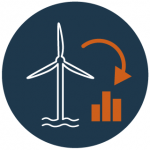ORE Catapult’s blade experts are developing a bi-axial testing method to address the challenge of reducing the duration and costs of blade testing, also making it more representative of real-world operating conditions. This joint industry and academic collaboration aims to reduce the overall test program duration by up to 25% and fatigue test duration by almost 50%.
ORE Catapult’s bi-axial testing method involves understanding the theoretical fatigue damage of a blade during its service life. This is done using fatigue analysis software, developed by ORE Catapult and certified by DNV-GL, ensuring that the physical test loads replicate the service life damage over as much of a blade as possible. With data from the analysis, a bi-axial test can be designed and undertaken, exciting the blade in the flapwise and edgewise directions simultaneously to more accurately represent the fatigue that a blade in the field would experience over its lifetime.
This joint industry and academic collaboration aims to reduce the overall test program duration by up to 25% and fatigue test duration by almost 50%.
Bi-axial moves away from conventional methods of testing, and can also be presented to a certification body. Having attracted significant interest from industry, the bi-axial testing programme is now set to be upscaled to become part of the XL-BLADE DemoWind project, alongside project partners ADWEN and LM Wind Power, validating one of the world’s longest offshore wind blades at 88.4m.
Download

